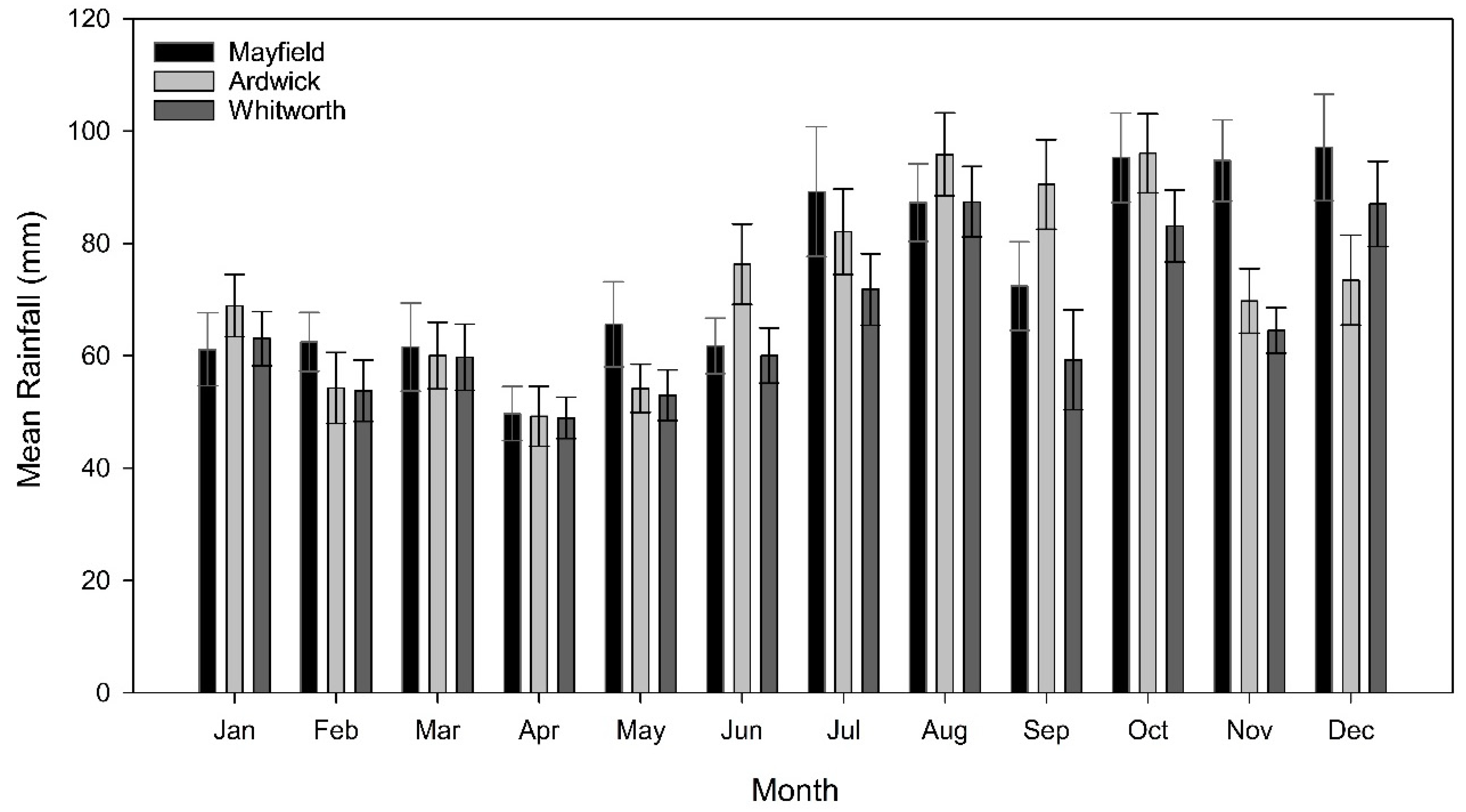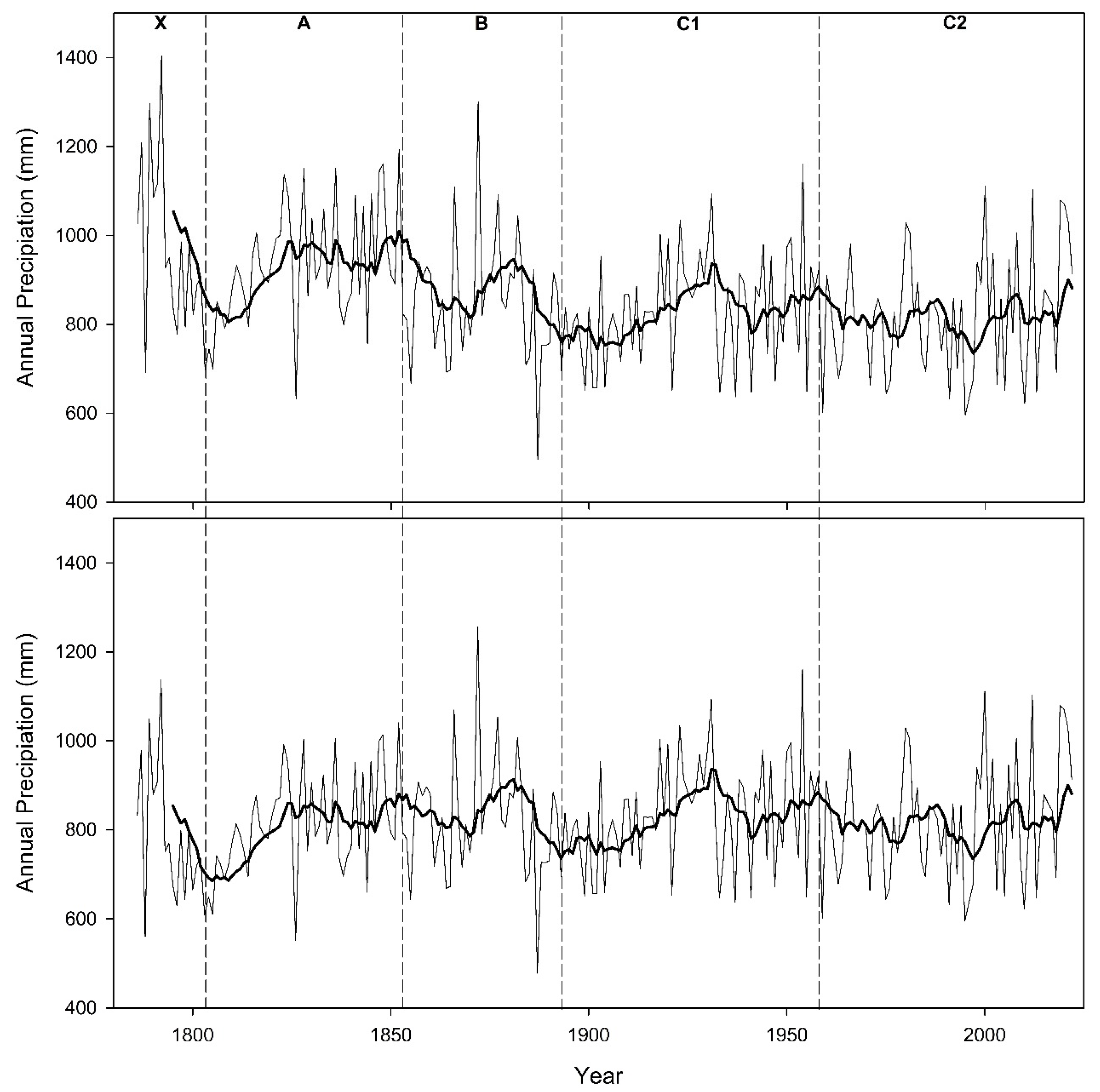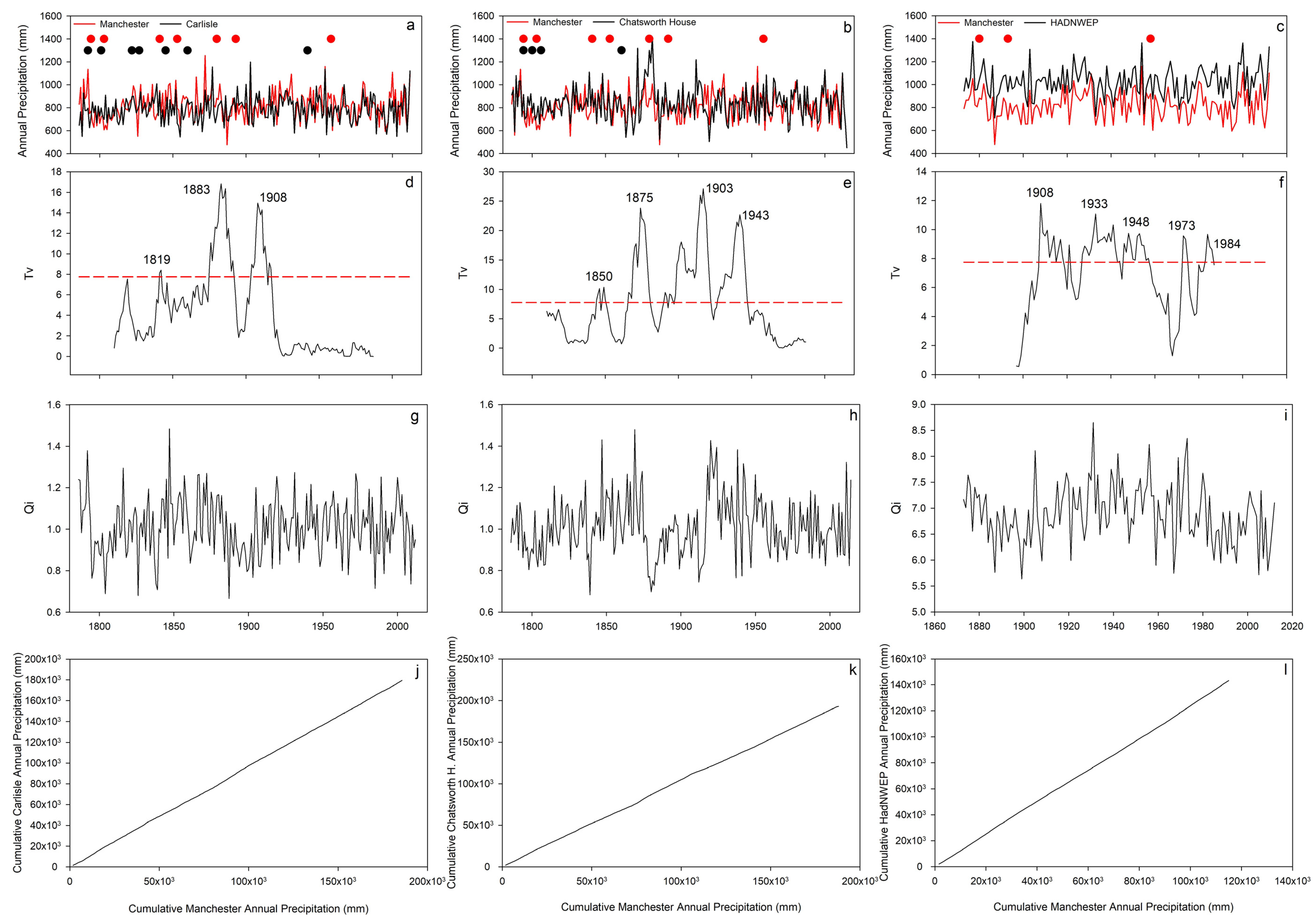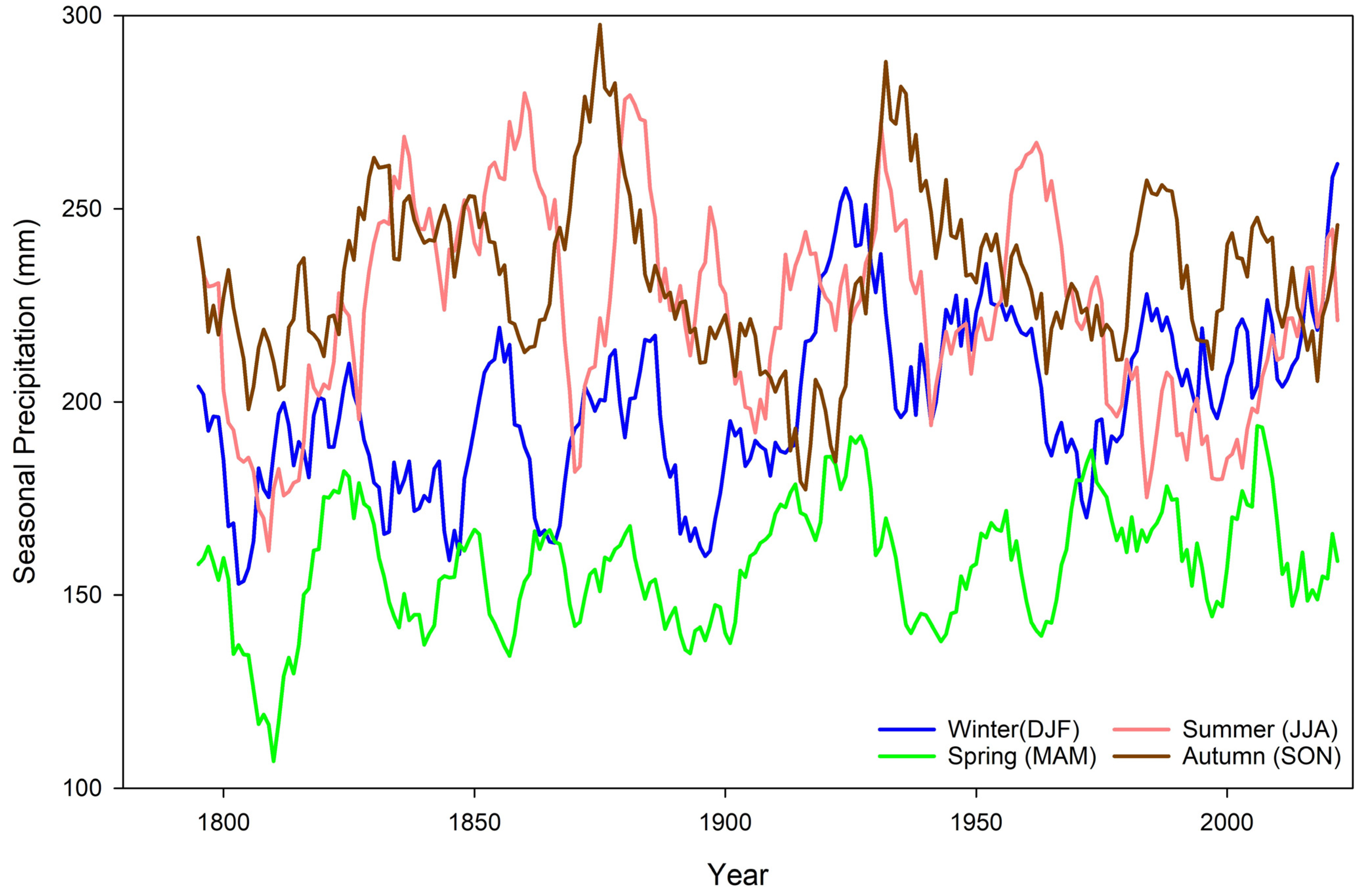Reassessing and Extending the Composite Rainfall Record of Manchester, Northwest England: 1786–Present
Abstract
1. Introduction
- Revisiting the original sources of historic rainfall data identified by Manley [8], coupled with the acquisition of contemporary meteorological station data for Manchester.
- Reconstructing the record using statistical techniques to infill and bridge gaps between station records.
- Statistically assessing the homogeneity of the record through comparisons with other long-term homogenous rainfall series representative of the region; Carlisle 1757–2012 from Todd et al. [3], and Chatsworth House, 1777–2015 [9], and the Hadley Centre’s northwest England rainfall series (HadNWEP 1873–2015 from Alexander & Jones [10] and Simpson & Jones [11]).
- Statistically analysing the series to determine long-term seasonal and annual variability, focusing on extreme wet/dry seasons and events, and to identify long-term trends.
2. Historical Instrumental Rainfall Observations and Reconstructions
3. Methodology
- A visual inspection of the plotted long rainfall series to identify inhomogeneities indicated by clear discontinuities (steps or breaks).
- A double-mass curve test [33] using the Manchester rainfall record and data from three series representative of sites in the region (Carlisle, Chatsworth House, and HadNWEP).
- A standard normal homogeneity test (SNHT) [34] also using the Manchester, Carlisle, Chatsworth House, and HadNWEP rainfall records.
- An analysis of station metadata to explore possible causes of inhomogeneities [18].
4. History of Rainfall Recording in Manchester
“On a comparison of our results for 8 subsequent years, I found his average exceed mine, by about 4 inches in the year… On inspecting his gage [sic], I had reason to think his mode of measuring the rain was not susceptible of sufficient accuracy, and suggest the same to him, with which he seemed to acquiesce.”
“The rain-gage [sic] has been all the time situate in the garden on the S.E. side of Manchester; it is twenty yards distant from any house or elevated object that can influence the fall of rain. The gage is a funnel of 10 inches diameter, and the top is surrounded by a perpendicular rim of 3 inches high, to prevent any loss by the spray; it is fixed in a proper frame with a bottle for the water, and it stands above 2 feet above ground.”(Dalton. 1819, p.495)
5. Station Selection and Analysis
5.1. Station Selection
5.2. Statistical Comparison of the Primary Stations
5.3. Linear Regression Analysis
5.4. Visual Identification and Correction of Inhomogeneities
5.5. Homogeneity Testing
5.6. Identifying Causes of Statistical Inhomogeneity
6. Analysis of the Manchester Rainfall Record
“It was about half past twelve when the floods came… the banks of the Medlock were overflowed to such an alarming extent and the first intimation of the flood was the sweeping away of a footbridge near to Philips Park… The flood increased in depth and power, and at a length swept in a fierce torrent over a large portion of ground apportioned to the Roman Catholics at the Bradford Cemetery carrying away not only tombstones but actually washing out of their graves, a large number of dead bodies. Indeed, from the first indication of danger, so far as works on the banks of the Medlock were concerned, dead bodies were observed floating down the river, and those watching could easily see that the bodies had been disinterred out of the Bradford cemetery. It is impossible to calculate how many had been swept out of their final resting place but the number is not short of fifty.”
7. Summary
Author Contributions
Funding
Data Availability Statement
Conflicts of Interest
References
- Brázdil, R.; Pfister, C.; Wanner, H.; Von Storch, H.; Luterbacher, J. Historical Climatology in Europe—The State of the Art. Clim. Change 2005, 70, 363–430. [Google Scholar] [CrossRef]
- Brázdil, R.; Černušák, T.; Ŗezníćková, L. Weather information in the diaries of the Premonstratensian Abbey at Hradisko, in the Czech Republic, 1693–1783. Weather 2008, 63, 201–207. [Google Scholar] [CrossRef]
- Todd, B.; Macdonald, N.; Chiverrell, R.C. Revision and extension of the composite Carlisle rainfall record, northwest England: 1757–2012. Int. J. Climatol. 2015, 35, 3593–3607. [Google Scholar] [CrossRef]
- Brázdil, R.; Zahradníček, P.; Pišoft, P.; Štěpánek, P.; Bělínová, M.; Dobrovolný, P. Temperature and precipitation fluctuations in the Czech Republic during the period of instrumental measurements. Theor. Appl. Climatol. 2012, 110, 17–34. [Google Scholar] [CrossRef]
- Pauling, A.; Luterbacher, J.; Casty, C.; Wanner, H. Five hundred years of gridded high-resolution precipitation reconstructions over Europe and the connection to large-scale circulation. Clim. Dyn. 2006, 26, 387–405. [Google Scholar] [CrossRef]
- Murphy, C.; Broderick, C.; Burt, T.P.; Curley, M.; Duffy, C.; Hall, J.; Harrigan, S.; Matthews, T.K.R.; Macdonald, N.; McCarthy, G.; et al. A 305-year continuous monthly rainfall series for the island of Ireland (1711–2016). Clim. Past 2018, 14, 413–440. [Google Scholar] [CrossRef]
- Schönwiese, C.D.; Walter, A.; Brinckmann, S. Statistical assessments of anthropogenic and natural global climate forcing. An update. Meteorol. Z. 2010, 19, 3–10. [Google Scholar] [CrossRef]
- Manley, G. Manchester rainfall since 1765. Manch. Men. 1972, 114, 1–20. [Google Scholar]
- Harvey-Fishenden, A.; Macdonald, N.; Bowen, J.P. Dry weather fears of Britain’s early ‘industrial’ canal network. Reg. Environ. Change 2019, 19, 2325–2337. [Google Scholar] [CrossRef]
- Alexander, L.V.; Jones, P.D. Updated Precipitation Series for the U.K. and Discussion of Recent Extremes. Atmos. Sci. Lett. 2001, 1, 142–150. [Google Scholar] [CrossRef]
- Simpson, I.R.; Jones, P.D. Updated precipitation series for the UK derived from Met Office gridded data. Int. J. Climatol. 2012, 32, 2271–2282. [Google Scholar] [CrossRef]
- Camuffo, D.; Bertolin, C.; Diodato, N.; Cocheo, C.; Barriendos, M.; Dominguez-Castro, F.; Garnier, E.; Alcoforado, M.J.; Nunes, M.F. Western Mediterranean precipitation over the last 300 years from instrumental observations. Clim. Change 2013, 117, 85–101. [Google Scholar] [CrossRef]
- Camuffo, D.; Bertolin, C. The earliest temperature observations in the world: The Medici Network (1654–1670). Clim. Change 2012, 111, 335–363. [Google Scholar] [CrossRef]
- Craddock, J.M. Annual rainfall in England since 1725. Q. J. R. Met. Soc. 1976, 102, 823–840. [Google Scholar] [CrossRef]
- Folland, C.K.; Wales-Smith, B.G. Richard Towneley and 300 years of regular rainfall measurement. Weather 1977, 32, 438–445. [Google Scholar] [CrossRef]
- Murphy, C.; Wilby, R.L.; Matthews, T.K.R.; Thorne, P.; Broderick, C.; Fealy, R.; Hall, J.; Harrigan, S.; Jones, P.; McCarthy, G.; et al. Multi-century trends to wetter winters and drier summers in the England and Wales precipitation series explained by observational and sampling bias in early records. Int. J. Climatol. 2020, 40, 610–619. [Google Scholar] [CrossRef] [PubMed]
- Craddock, J.M.; Wales-Smith, B.G. Monthly rainfall totals representing the East Midlands for the years 1726 to 1975. Meteorol. Mag. 1977, 106, 97–111. [Google Scholar]
- Aguilar, E.; Auer, I.; Brunet, M.; Peterson, T.C.; Wieringa, J. Guidelines on climate metadata and homogenization. In World Climate Data and Monitoring Programme; WMO/TD 1186; World Meteorological Institution: Geneva, Switzerland, 2003; Volume 53. [Google Scholar]
- Burt, S. British Rainfall 1860–1993. Weather 2010, 65, 121–128. [Google Scholar] [CrossRef]
- Craddock, J.M.; Craddock, E. Rainfall at Oxford from 1767 to 1814, estimated from the records of Dr Thomas Hornsby and others. Meteorol. Mag. 1977, 106, 361–371. [Google Scholar]
- Todd, B. Reconstructing Long-Term Records of UK Drought and Analysis of Variability: 1697–2013. Ph.D. Thesis, University of Liverpool, Liverpool, UK, 2014. [Google Scholar]
- Burt, S.; Burt, T. Oxford Weather and Climate Since 1767; Oxford University Press: Oxford, UK, 2019. [Google Scholar] [CrossRef]
- Burt, S.; Burt, T. Durham Weather and Climate Since 1841; Oxford University Press (OUP): Oxford, UK, 2022. [Google Scholar]
- Macdonald, N.; Naylor, S.; Bowen, J.P.; Harvey-Fishenden, A.; Graham, E.E. Understanding weather futures based on the past: A case of Stornoway, Outer Hebrides. Scott. Geogr. J. 2023, 139, 115–132. [Google Scholar] [CrossRef]
- Barker, P.A.; Wilby, R.L.; Borrows, J. A 200-year precipitation index for the central English Lake District/Un indice de précipitation de 200 ans pour la Région des Lacs en Angleterre. Hydrol. Sci. J. 2004, 49, 785. [Google Scholar] [CrossRef][Green Version]
- Wigley, T.M.L.; Jones, P.D. England and Wales precipitation: A discussion of recent changes in ariability and an update to 1985. J. Climatol. 1987, 7, 231–246. [Google Scholar] [CrossRef]
- Osborn, T.J.; Hulme, M.; Jones, P.D.; Basnett, T.A. Observed trends in the daily intensity of United Kingdom precipitation. Int. J. Climatol. 2000, 20, 347–364. [Google Scholar] [CrossRef]
- Burt, T.P.; Horton, B.P. Inter-decadal variability in daily rainfall at Durham (UK) since the 1850s. Int. J. Climatol. 2007, 27, 945–956. [Google Scholar] [CrossRef]
- Little, M.A.; Rodda, H.J.E.; McSharry, P.E. Bayesian objective classification of extreme UK daily rainfall for flood risk applications. Hydrol. Earth Syst. Sci. Discuss. 2008, 5, 3033–3060. [Google Scholar]
- Macdonald, N.; Phillips, I.D.; Thorpe, J. Reconstruction of long-term precipitation records for Edinburgh: An examination of the mechanisms responsible for temporal variability in precipitation. Theor. Appl. Climatol. 2008, 92, 141–154. [Google Scholar] [CrossRef]
- Peterson, T.C.; Easterling, D.R.; Karl, T.R.; Groisman, P.; Nicholls, N.; Plummer, N.; Torok, S.; Auer, I.; Boehm, R.; Gullett, D.; et al. Homogeneity adjustments of in situ atmospheric climate data: A review. Int. J. Climatol. 1998, 18, 1493–1517. [Google Scholar] [CrossRef]
- Peterson, T.C.; Easterling, D.R. Creation of homogeneous composite climatological reference series. Int. J. Climatol. 1994, 14, 671–679. [Google Scholar] [CrossRef]
- Searcy, J.K.; Hardison, C.H. Double-Mass Curves. In Geological Survey Water-Supply Paper; United States Government Printing Office: Washington, DC, USA, 1960; Volume 1541-B, pp. 31–66. [Google Scholar]
- Alexandersson, H. A homogeneity test applied to precipitation data. J. Climatol. 1986, 6, 661–675. [Google Scholar] [CrossRef]
- Manchester Medical Collection (n.d.) George Lloyd, 1708–1783. Biographical Files H-Q 1727—[Collection available at John Rylands University Library archives]. Available online: https://archiveshub.jisc.ac.uk/search/archives/30ac920b-4c0f-3422-a80e-0e29e9a7e85c (accessed on 9 January 2024).
- Dalton, J. Observations on the barometer, thermometer and rain at Manchester: From 1794 to 1818 inclusive. Manch. Lit. Phil. Soc. Mem. Proc. 1819, 6, 561–589. [Google Scholar]
- Smith, R. Memoir of John Dalton and History of the Atomic Theory; H. Bailliere: London, UK, 1856. [Google Scholar]
- Dalton, J. Meteorological Observations and Essays; T. OSTELL: London, UK, 1793. [Google Scholar]
- Vernon, G.V. On the rainfall at Old Trafford, Manchester, during the years 1867. Manch. Lit. Phil. Soc. Mem. Proc. 1868, 5, 124–130. [Google Scholar]
- Centre for Atmospheric Science. History of the Whitworth Observatory (Centre for Atmospheric Science—The University of Manchester). 2016. Available online: http://www.cas.manchester.ac.uk/restools/whitworth/history/ (accessed on 13 September 2016).
- Wigbout, M. Limitations in the use of double-mass curves. J. Hydrol. 1973, 12, 132–138. [Google Scholar]
- Cole, G.A.; Marsh, T.J. The Impact of Climate Change on Severe Droughts: Major Droughts in England and Wales from 1800 and Evidence of Impact; Science Report: SC040068/SR1; Environment Agency: Bristol, UK, 2006; pp. 1–54. [Google Scholar]
- Fowler, H.J.; Kilsby, C.G. A weather-type approach to analysing water resource drought in the Yorkshire region from 1881 to 1998. J. Hydrol. 2002, 262, 177–192. [Google Scholar] [CrossRef]
- Marsh, T.; Cole, G.; Wilby, R. Major droughts in England and Wales, 1800–2006. Weather 2007, 62, 87–93. [Google Scholar] [CrossRef]
- Barker, L.J.; Hannaford, J.; Parry, S.; Smith, K.A.; Tanguy, M.; Prudhomme, C. Historic hydrological droughts 1891–2015: Systematic characterisation for a diverse set of catchments across the UK. Hydrol. Earth Syst. Sci. 2019, 23, 4583–4602. [Google Scholar] [CrossRef]
- Lennard, A.T.; Macdonald, N.; Clark, S.; Hooke, J.M. The application of a drought reconstruction in water resource management. Hydrol. Res. 2015, 47, 646–659. [Google Scholar] [CrossRef]
- Dayrell, C.; Svensson, C.; Hannaford, J.; McEnery, T.; Barker, L.J.; Baker, H.; Tanguy, M. Representation of Drought Events in the United Kingdom: Contrasting 200 years of News Texts and Rainfall Records. Front. Environ. Sci. 2022, 10, 760147. [Google Scholar] [CrossRef]
- Eden, P. Great British Weather Disasters; Continuum UK: London, UK, 2008. [Google Scholar]
- Hannaford, J. Observed Long-Term Changes in UK River Flow Patterns: A Review; Water Report Card; National River Flow Archive Centre for Ecology and Hydrology: Wallingford, UK, 2013; pp. 1–37. [Google Scholar]
- Manchester Courier. The Great Flood; Manchester Courier: Manchester, UK, 1872. [Google Scholar]
- Keeling, N. Looking Back: Salford Floods Were Worst in 70 Years. MEN. 2015. Available online: http://www.manchestereveningnews.co.uk/news/greater-manchester-news/looking-back-salford-floods-were-10656774 (accessed on 13 September 2016).
- Medlock Valley Information, 1st ed. 2016. Available online: http://medlockvalley.org.uk/Sites/MedlockValley/Objects/PDFs/The_Great_Flood.pdf (accessed on 1 September 2016).
- Jones, P.D.; Conway, D. Precipitation in the British Isles: An analysis of area—Average data updated to 1995. Int. J. Climatol. 1997, 17, 427–438. [Google Scholar] [CrossRef]
- Jenkins, G.J.; Perry, M.C.; Prior, M.J. The Climate of the United Kingdom and Recent Trends; Met Office Hadley Centre: Exeter, UK, 2008. [Google Scholar]
- Macdonald, N.; Sangster, H. High-magnitude flooding across Britain since AD 1750. Hydrol. Earth Syst. Sci. 2017, 21, 1631–1650. [Google Scholar] [CrossRef]
- Brázdil, R.; Dobrovolný, P.; Luterbacher, J.; Moberg, A.; Pfister, C.; Wheeler, D.; Zorita, E. European climate of the past 500 years: New challenges for historical climatology. Clim. Change 2010, 101, 7–40. [Google Scholar] [CrossRef]





| Site (Station ID) | Observer | Years | Notes |
|---|---|---|---|
| Greengate, Salford | George Walker | 1786–1793 | Start of composite record. |
| New College, Dawson Street (also known as Mosley St) | John Dalton | 1794–1802 | Details unknown; “similar to Kendal gauge?” [8]. Kendal gauge: 10 in diameter. |
| Mayfield | John Dalton | 1803–1840 | Missing data: Mar–Apr 1807, Dec 1809, and Jan–Feb 1811. Filled in using linear regression with Hanson’s record at Lying-in hospital 1.86 km away (below). Rain gauge: 10 in diameter, on bench >2 ft off ground in Thomas Hoyle’s garden, fairly open. Small changes in exposure through time [8]. |
| Lying-in Hospital | Thomas Henry Hanson | 1807–1811 | Used to infill Mayfield. Gauge: 6 in diameter, on hospital roof. |
| Market Street | Joseph Casartelli | 1841–1852 | Gauge: 5 in diameter, 3 ft above ground, sheltered by high wall to the east. |
| Ardwick | Joseph Casartelli | 1853–1879 | Gauge: 8.5 in diameter, 3 ft above ground [8]. |
| Gorton Reservoir (11,971) | J. Bateman/ G.H. Hill | 1880–1892 | Gauge: 12 in diameter, 2 ft above ground. |
| Whitworth Park Observatory (16,844) | Manchester University | 1893–1957 | Gauge: 8 in diameter, 1 ft above ground. |
| Ringway Airport (1135) | Meteorological Office | 1951–2004 | Used to infill Denton gap. Gauge: 5 in diameter, 1ft above ground. |
| Denton Reservoir (11,958) | Manchester Waterworks | 1958–2023 | Missing data: 1960-Jan 1979. Filled using LR with Ringway 15.09 km SW. Gauge at 306 ft, below embankment previously level with, generally 2 ft above ground [8]. |
| Stage | Dependent Variable | Independent Variable | Overlap Period | Slope (m) | Intercept (c) | R2 |
|---|---|---|---|---|---|---|
| X | Greengate, Salford | NA | NA | NA | NA | NA |
| New College, Dawson St | NA | NA | NA | NA | NA | |
| A1 | Mayfield | Lying-in Hospital Market Street | 1807–1811 | 0.998 | −0.101 | 0.893 |
| A2 | Mayfield | 1830–1840 | 0.901 | 12.242 | 0.967 | |
| B | Ardwick | Gorton Reservoir | 1860–1879 | 0.978 | 3.067 | 0.974 |
| C1 | Whitworth | Denton Reservoir | 1931–1957 | 0.932 | −2.539 | 0.979 |
| 2003–2023 | ||||||
| C2 | Denton Reservoir * | Ringway Airport | 1980–2003 | 0.973 | 1.267 | 0.964 |
| Site | Total (mm) | Mean (mm) | Standard Deviation (mm) | Maximum (mm) | Minimum (mm) |
|---|---|---|---|---|---|
| Manchester | 114,885.0 | 68.4 | 35.4 | 216.7 | 1.4 |
| Carlisle | 111,965.8 | 66.7 | 35.5 | 242.3 | 2.0 |
| Chatsworth House | 118,936.3 | 70.8 | 39.8 | 284.4 | 1.0 |
| HadNWEP | 143,213.3 | 85.3 | 40.8 | 245.4 | 3.7 |
| Wettest Years | Driest Years | ||
|---|---|---|---|
| Year | Rainfall (mm) | Year | Rainfall (mm) |
| 1872 | 1255.5 | 1887 | 478.2 |
| 1954 | 1160.3 | 1826 | 552.1 |
| 1792 | 1136.5 | 1788 | 560.5 |
| 2000 | 1111.1 | 1995 | 595.6 |
| 2012 | 1102.3 | 1959 | 602.0 |
| 1931 | 1094.2 | 1803 | 608.6 |
| 2019 | 1079.2 | 1805 | 610.1 |
| 2020 | 1071.2 | 2010 | 622.8 |
| 1866 | 1069.3 | 1796 | 630.1 |
| 1877 | 1052.8 | 1991 | 631.9 |
Disclaimer/Publisher’s Note: The statements, opinions and data contained in all publications are solely those of the individual author(s) and contributor(s) and not of MDPI and/or the editor(s). MDPI and/or the editor(s) disclaim responsibility for any injury to people or property resulting from any ideas, methods, instructions or products referred to in the content. |
© 2024 by the authors. Licensee MDPI, Basel, Switzerland. This article is an open access article distributed under the terms and conditions of the Creative Commons Attribution (CC BY) license (https://creativecommons.org/licenses/by/4.0/).
Share and Cite
Macdonald, N.; Dietz, R. Reassessing and Extending the Composite Rainfall Record of Manchester, Northwest England: 1786–Present. Climate 2024, 12, 21. https://doi.org/10.3390/cli12020021
Macdonald N, Dietz R. Reassessing and Extending the Composite Rainfall Record of Manchester, Northwest England: 1786–Present. Climate. 2024; 12(2):21. https://doi.org/10.3390/cli12020021
Chicago/Turabian StyleMacdonald, Neil, and Robert Dietz. 2024. "Reassessing and Extending the Composite Rainfall Record of Manchester, Northwest England: 1786–Present" Climate 12, no. 2: 21. https://doi.org/10.3390/cli12020021
APA StyleMacdonald, N., & Dietz, R. (2024). Reassessing and Extending the Composite Rainfall Record of Manchester, Northwest England: 1786–Present. Climate, 12(2), 21. https://doi.org/10.3390/cli12020021






